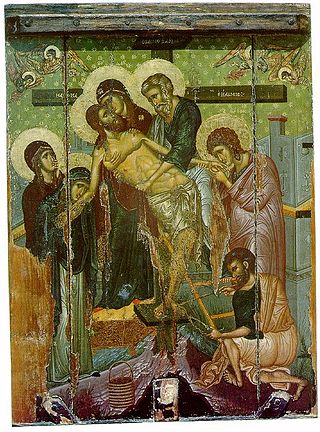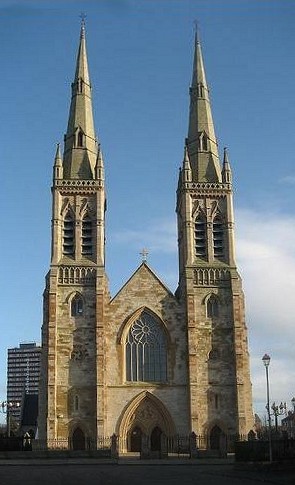
Anointing of the sick, known also by other names such as unction, is a form of religious anointing or "unction" for the benefit of a sick person. It is practiced by many Christian churches and denominations.

The last rites, also known as the Commendation of the Dying, are the last prayers and ministrations given to an individual of Catholic faith, when possible, shortly before death. They may be administered to those awaiting execution, mortally injured, or terminally ill. Last rites cannot be performed on someone who has already died. Last rites, in sacramental Christianity, can refer to multiple sacraments administered concurrently in anticipation of an individual's passing.

Joseph of Arimathea was, according to all four canonical gospels, the man who assumed responsibility for the burial of Jesus after his crucifixion. The historical location of Arimathea is uncertain, although it has been identified with several towns. A number of stories that developed during the Middle Ages connect him with Glastonbury, England, and also with the Holy Grail legend.

Viaticum is a term used – especially in the Catholic Church – for the Eucharist, administered, with or without Anointing of the Sick, to a person who is dying; viaticum is thus a part of the Last Rites.

Martha is a biblical figure described in the Gospels of Luke and John. Together with her siblings Lazarus and Mary of Bethany, she is described as living in the village of Bethany near Jerusalem. She was witness to Jesus resurrecting her brother, Lazarus.

Saint Finbar, Finbarr, Finnbar, or Finnbarr, in Irish Fionnbharra, very often abbreviated to Barra, was Bishop of Cork and abbot of a monastery in what is now the city of Cork, Ireland. He is patron saint of the city and of the Diocese of Cork. His feast day is 25 September.

April 13 - Eastern Orthodox liturgical calendar - April 15

The Diocese of Down and Connor, is a Latin Church ecclesiastical territory or diocese of the Catholic Church in Northern Ireland. It is one of eight suffragan dioceses in the ecclesiastical province of the metropolitan Archdiocese of Armagh. The See is vacant; Bishop Donal McKeown is currently the Apostolic Administrator pending the appointment of a new bishop.

The Sinner's prayer is an evangelical Christian term referring to any prayer of repentance, prayed by individuals who feel sin in their lives and have the desire to form or renew a personal relationship with God through Jesus Christ. It is a popular prayer in evangelical circles. It is not intended as liturgical like a creed or a confiteor said or chanted within the Catholic Mass, but rather, is intended to be an act of initial conversion to Christianity; at the same time, it is roughly analogous to the Catholic Act of Contrition, though the theology behind each is markedly different, due to the intrinsically different views of salvation between Catholicism and Protestantism. While some Christians see reciting the Sinner's prayer as the moment defining one's salvation, others see it as a beginning step of one's lifelong faith journey.

Eucharist is the name that Catholics give to the sacrament by which, according to their belief, the body and blood of Christ are present in the bread and wine that are consecrated during the Catholic eucharistic liturgy, generally known as the Mass. The definition of the Eucharist in the 1983 Code of Canon Law as the sacrament where Christ himself "is contained, offered, and received" points to the three aspects of the Eucharist according to Catholic theology: the real presence of Christ in the Eucharist, Holy Communion, and the holy sacrifice of the Mass.

The sacrament of holy orders in the Catholic Church includes three orders: bishops, priests, and deacons, in decreasing order of rank, collectively comprising the clergy. In the phrase "holy orders", the word "holy" means "set apart for a sacred purpose". The word "order" designates an established civil body or corporation with a hierarchy, and ordination means legal incorporation into an order. In context, therefore, a group with a hierarchical structure that is set apart for ministry in the Church.

Saint Conleth was an Irish hermit and metalworker, also said to have been a copyist and skilled illuminator of manuscripts. He is believed to have come from the Wicklow area.

Assicus(Asicus, Assic) was the first bishop of Elphin, Ireland, and venerated as the patron saint of that place. He was also an artisan metalworker.
Columba of Terryglass (Colum) was the son of Ninnidh, a descendant of Crinthainn, King of Leinster. Columba was a disciple of St. Finnian of Clonard. He was one of the Twelve Apostles of Ireland.

The Diocese of Armagh is the metropolitan diocese of the ecclesiastical province of Armagh, the Church of Ireland province that covers the northern half (approximately) of the island of Ireland. The diocese mainly covers counties Louth, Tyrone and Armagh, and parts of Down. The diocesan bishop is also the Archbishop of Armagh, the archbishop of the province, and the Primate of All Ireland. The Archbishop has his seat in St Patrick's Cathedral in the town of Armagh.

In the Catholic Church, the anointing of the sick, also known as Extreme Unction, is a Catholic sacrament that is administered to a Catholic "who, having reached the age of reason, begins to be in danger due to sickness or old age", except in the case of those who "persevere obstinately in manifest grave sin". Proximate danger of death, the occasion for the administration of Viaticum, is not required, but only the onset of a medical condition of serious illness or injury or simply old age: "It is not a sacrament for those only who are at the point of death. Hence, as soon as anyone of the faithful begins to be in danger of death from sickness or old age, the fitting time for him to receive this sacrament has certainly already arrived."

Sutton-on-Trent is a large village and parish in Nottinghamshire, situated on the Great North Road, and on the west bank of the River Trent.
Patrick McAlister (1826–1895) was an Irish Roman Catholic Prelate and 24th Lord Bishop of Down and Connor.

Spiritual communion is a Christian practice of desiring union with Jesus Christ in the Eucharist. It is used as a preparation for Mass and by individuals who cannot receive holy communion.

Lecale is a peninsula in the east of County Down, Northern Ireland. It lies between Strangford Lough and Dundrum Bay. In the Middle Ages it was a district or túath in the Gaelic Irish kingdom of Ulaid, then became a county in the Anglo-Norman Earldom of Ulster. Later it became a barony, which was split into Lecale Lower and Lecale Upper by 1851. Its largest settlement is the town of Downpatrick. Other settlements include Ardglass, Killough and Strangford. The peninsula has a high concentration of tower houses. Much of it is part of the 'Strangford and Lecale' Area of Outstanding Natural Beauty.


















